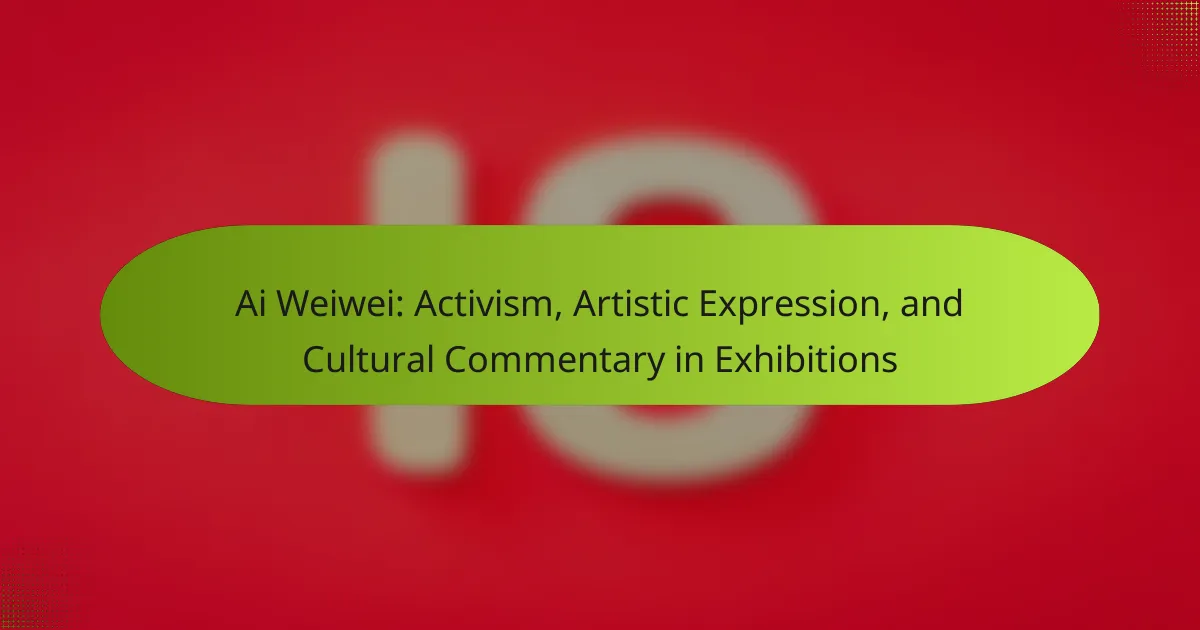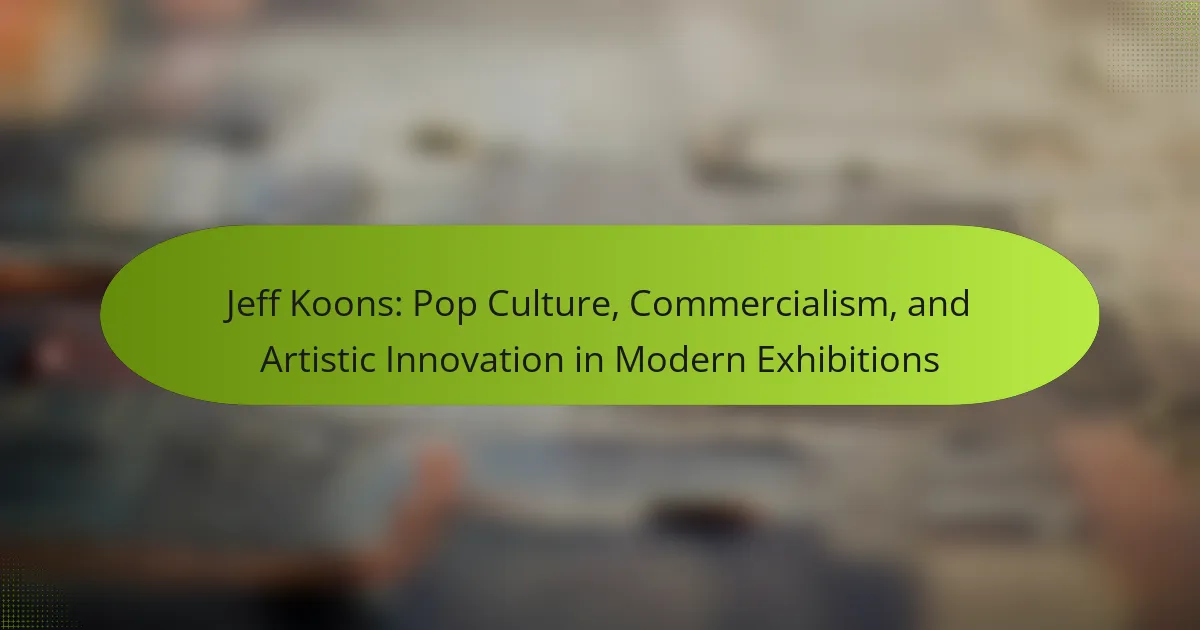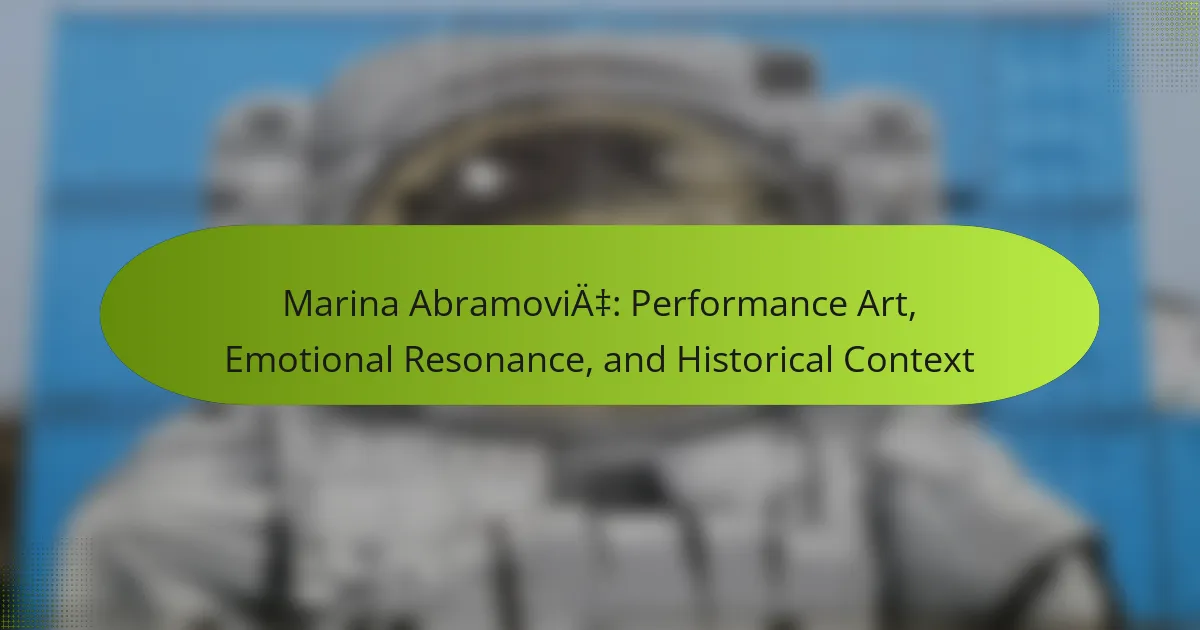Cindy Sherman’s work challenges traditional views of identity and representation in art. She explores the fluidity of identity through diverse personas in her photography. Her narratives critique societal roles and stereotypes, prompting viewers to rethink perceptions of gender. Sherman’s unique approach emphasizes the complexities of self-representation and the cultural implications of her art.
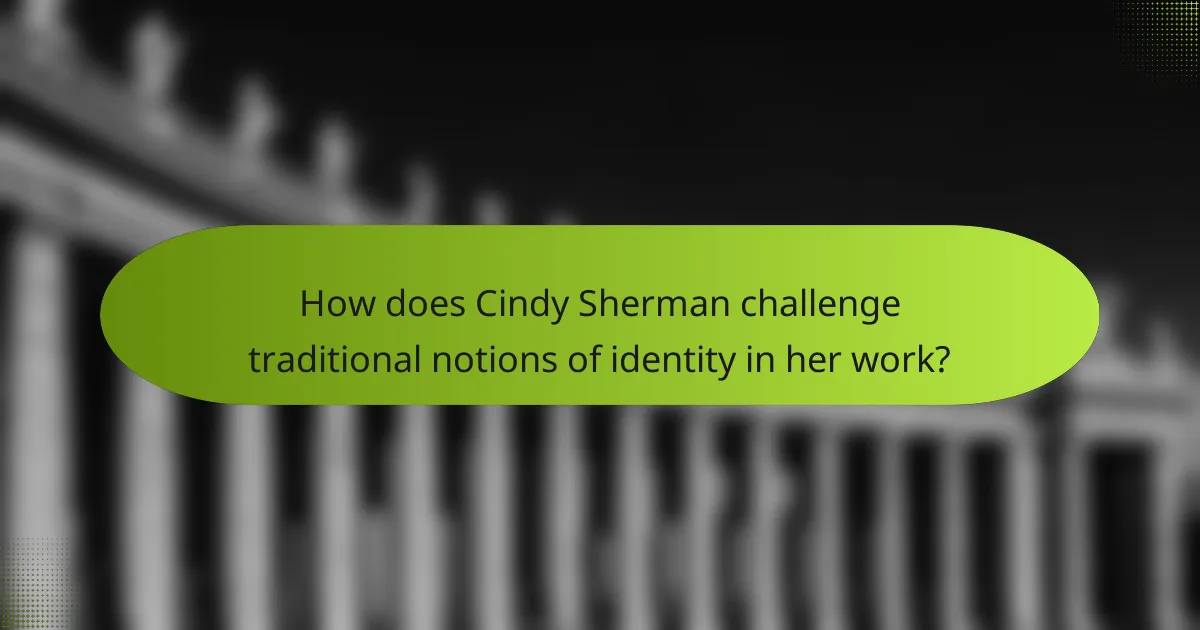
How does Cindy Sherman challenge traditional notions of identity in her work?
Cindy Sherman challenges traditional notions of identity by using her own image to create diverse personas. Through photography, she explores the fluidity of identity, emphasizing its constructed nature. Her work often critiques societal roles and stereotypes, inviting viewers to question their perceptions. By embodying various characters, Sherman highlights the complexity of self-representation, making identity a central theme in contemporary art.
What techniques does Sherman use to explore self-representation?
Cindy Sherman employs various techniques to explore self-representation, including staged photography, character creation, and manipulation of visual narratives. Through her work, she challenges traditional notions of identity and representation. Sherman uses costumes, makeup, and props to transform herself into diverse personas, effectively questioning societal norms regarding gender and identity. Her series, such as “Untitled Film Stills,” exemplifies this approach by blending cinematic tropes with personal storytelling, allowing viewers to engage with the complexities of self-representation.
How does her background influence her artistic choices?
Cindy Sherman’s background significantly shapes her artistic choices, particularly in identity exploration. Growing up in New Jersey, she was influenced by the cultural narratives surrounding femininity. Her education at Buffalo State College introduced her to feminist theory, which informs her visual storytelling. Sherman often critiques societal norms by embodying various characters, reflecting her unique perspective on representation. This approach allows her to challenge traditional roles and explore the complexities of identity.

What role does visual storytelling play in Cindy Sherman’s photography?
Visual storytelling is central to Cindy Sherman’s photography, as it explores identity and representation. Through her self-portraits, Sherman constructs narratives that challenge societal norms and expectations. Each image serves as a commentary on the roles women play in culture, revealing the complexities of identity. Sherman’s unique approach allows viewers to engage with the multifaceted nature of self-representation, making her work a powerful tool for visual storytelling.
Which narrative themes are prevalent in her series?
Cindy Sherman’s series prominently features themes of identity, transformation, and societal roles. Her work explores the complexities of self-representation through various personas. The use of disguise and costume highlights the fluidity of identity in contemporary culture. Additionally, Sherman critiques media portrayals of women, emphasizing the constructed nature of femininity.
How does Sherman utilize costume and makeup to convey different personas?
Cindy Sherman uses costume and makeup to create diverse personas that explore identity and representation. Each transformation reflects different aspects of societal roles and stereotypes. Through her art, Sherman challenges viewers to consider the fluidity of identity. Her unique ability to embody various characters allows for a deeper commentary on the nature of self and perception.
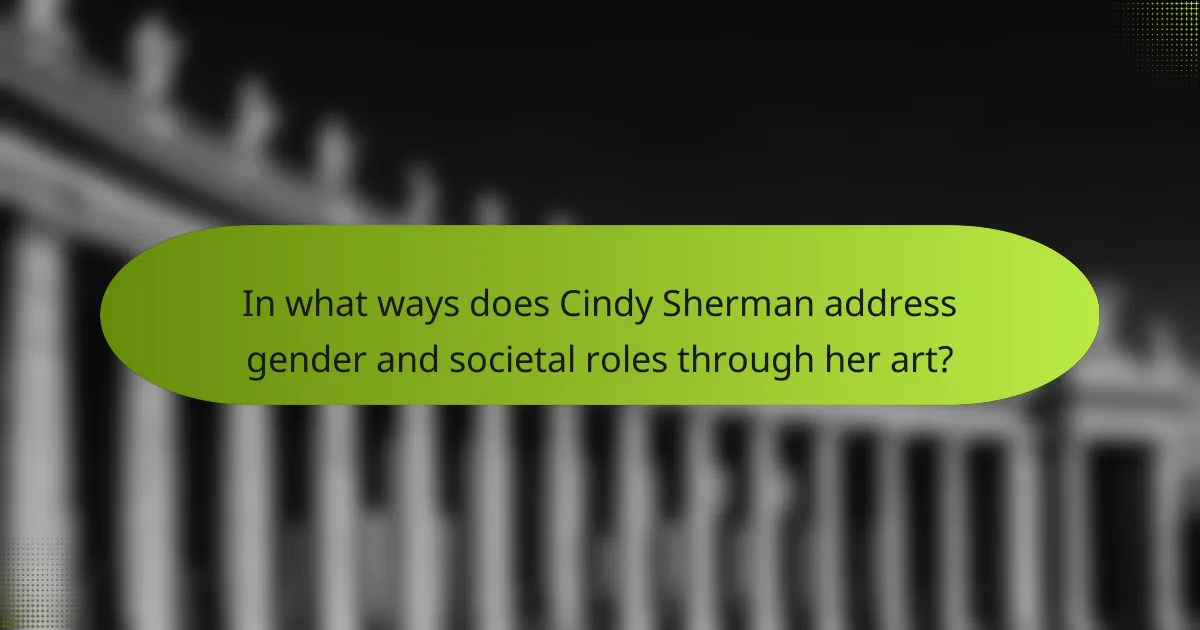
In what ways does Cindy Sherman address gender and societal roles through her art?
Cindy Sherman addresses gender and societal roles by challenging stereotypes and exploring identity through her photography. Her work often features herself in various roles, highlighting the performative nature of gender. By adopting different personas, she critiques societal expectations and the media’s portrayal of women. This unique approach invites viewers to question traditional narratives and consider the complexities of identity. Sherman’s art serves as a commentary on the constructed nature of gender, making her a pivotal figure in contemporary discussions about representation.
How do her works reflect the evolution of feminist art?
Cindy Sherman’s works reflect the evolution of feminist art by challenging traditional gender roles and identity representations. Her photography explores the complexities of female identity, using herself as a model to critique societal norms. Through various personas, Sherman highlights the performative aspects of femininity, revealing how identity is constructed rather than inherent. This unique approach resonates with feminist discourse, emphasizing the fluidity of gender and the impact of media on self-perception. Sherman’s art serves as a powerful commentary on the representation of women in visual culture, making her a pivotal figure in feminist art history.
What critiques has Sherman received regarding her portrayal of women?
Cindy Sherman has faced critiques regarding her portrayal of women, particularly for perceived stereotypes and lack of diversity. Critics argue her work can reinforce traditional gender roles, limiting the complexity of female identity. Additionally, some believe her focus on self-portraiture may prioritize the artist’s perspective over broader women’s experiences. This has sparked discussions about representation in contemporary art, emphasizing the need for varied narratives.

Which unique attributes set Cindy Sherman apart from other contemporary artists?
Cindy Sherman stands out due to her unique approach to identity and representation in art. Her use of photography to explore the concept of self and societal roles is unparalleled. Sherman’s ability to embody various characters challenges traditional notions of the artist’s identity. Additionally, her work often critiques media and cultural stereotypes, making her a pivotal figure in contemporary art. The innovative techniques she employs, such as transforming her appearance through costumes and makeup, further distinguish her from her peers.
How does her use of self-portraiture differ from traditional photography?
Cindy Sherman’s use of self-portraiture diverges from traditional photography by emphasizing identity exploration rather than mere representation. Unlike conventional photography, which often captures reality, Sherman constructs elaborate narratives through her staged personas. This approach challenges viewers to question the authenticity of identity and the role of the artist. Her work uniquely combines performance art with photography, allowing for a deeper exploration of societal roles and stereotypes. Additionally, her self-portraits often embody multiple characters, showcasing a rare ability to transform and critique cultural narratives.
What impact has her work had on the field of conceptual art?
Cindy Sherman has significantly influenced conceptual art by challenging identity and representation. Her work deconstructs traditional narratives, prompting viewers to question the authenticity of visual storytelling. Through a unique approach of self-portraiture, she explores societal roles and constructs, becoming a pivotal figure in feminist art discourse. Sherman’s innovative use of costume and makeup transforms her into various characters, showcasing the fluidity of identity. This has inspired subsequent artists to examine their own representations and the implications of visual culture.

What are the cultural implications of Sherman’s art in different regions?
Cindy Sherman’s art has diverse cultural implications across regions, reflecting unique societal narratives and identities. In the United States, her work challenges traditional gender roles and explores the complexities of identity in contemporary culture. In Europe, particularly in feminist art movements, her photography critiques the representation of women, influencing discussions on gender and power dynamics. In Asia, Sherman’s art resonates with themes of identity and self-representation, often contrasting Western ideals with local cultural contexts. Each region interprets her work through its cultural lens, highlighting the intersection of identity, representation, and visual storytelling.
How is her work perceived in European art circles compared to American audiences?
Cindy Sherman’s work is often perceived as more avant-garde and influential in European art circles compared to American audiences. European critics frequently highlight her exploration of identity and representation, viewing her as a pivotal figure in contemporary art. In contrast, American audiences may appreciate her work but often contextualize it within a broader commercial framework. This difference in perception illustrates the unique cultural lenses through which her visual storytelling is interpreted. European art circles tend to emphasize the conceptual depth of her photography, while American audiences may focus on its aesthetic appeal and marketability.
What local exhibitions have highlighted her contributions to contemporary art?
Cindy Sherman’s contributions to contemporary art have been highlighted in various local exhibitions, including the “Cindy Sherman: Works from the Collection” at the Museum of Modern Art. This exhibition showcased her unique approach to identity and representation through visual storytelling. Additionally, the “Cindy Sherman: The Complete Untitled Film Stills” exhibition at the San Francisco Museum of Modern Art emphasized her iconic series that explores the roles of women in media. These exhibitions reflect her enduring influence on contemporary art and discourse surrounding identity.

What common misconceptions exist about Cindy Sherman and her artistic intent?
Cindy Sherman often faces misconceptions about her artistic intent, primarily regarding identity and representation. Many viewers mistakenly interpret her work as mere self-portraits, overlooking its deeper commentary on societal roles and stereotypes. Critics sometimes reduce her photography to superficiality, ignoring the complex narratives she constructs around gender and identity. Additionally, some believe her work solely critiques the media’s portrayal of women, while it also explores broader themes of identity formation and the fluidity of self. This misunderstanding diminishes the impact of her visual storytelling and the nuanced conversations it invites.
How can understanding her background clarify her artistic message?
Understanding Cindy Sherman’s background enhances her artistic message by revealing how her personal experiences shape themes of identity and representation. Her work often reflects her exploration of societal norms and gender roles. Through her unique approach, Sherman challenges viewers to question established narratives. This context is vital for interpreting her visual storytelling, as it underscores the interplay between her identity and the characters she portrays.
What are the most frequent interpretations of her work that are inaccurate?
Cindy Sherman’s work is often misinterpreted as solely about self-portraiture, neglecting her commentary on societal roles and identity. Many viewers mistakenly see her photographs as autobiographical rather than explorations of cultural stereotypes. Additionally, some critics focus on the superficial aspects of her images, overlooking the deeper psychological and social critiques embedded within her art. This reductionist view fails to recognize the complexity of identity representation that Sherman masterfully conveys through visual storytelling.

What practical tips can be learned from Cindy Sherman’s approach to art?
Cindy Sherman’s approach to art emphasizes identity exploration, challenging representation, and innovative visual storytelling. Practical tips include embracing self-portraiture to explore personal narratives, utilizing diverse costumes and makeup to transform identity, and experimenting with photography techniques to enhance storytelling. Additionally, consider the impact of context and audience perception in your work. These strategies can deepen engagement and provoke thought, much like Sherman’s influential pieces.
How can emerging artists use her techniques to develop their own identity?
Emerging artists can adopt Cindy Sherman’s techniques to explore and express their identities through visual storytelling. By utilizing self-portraiture, they can create narratives that reflect personal experiences and societal roles. This approach encourages experimentation with various personas, allowing artists to challenge norms and engage viewers. Additionally, analyzing Sherman’s use of costume and makeup can inspire artists to manipulate their appearances to convey deeper meanings. Embracing these methods fosters a unique artistic voice rooted in personal and cultural exploration.
What are the best practices for analyzing visual storytelling in contemporary art?
Analyzing visual storytelling in contemporary art involves examining identity and representation through the lens of artists like Cindy Sherman. Best practices include focusing on the narrative techniques used, understanding the context of the work, and evaluating the impact on audience perception.
Consider the following practices:
1. **Contextual Analysis**: Investigate the socio-cultural background influencing the artwork.
2. **Character and Role Examination**: Analyze the identities portrayed and their significance.
3. **Visual Composition Assessment**: Evaluate how elements like color, form, and space contribute to storytelling.
4. **Audience Interaction**: Observe how viewers engage with the work and interpret the narratives presented.
These practices enhance the understanding of how contemporary artists communicate complex themes through visual storytelling.
